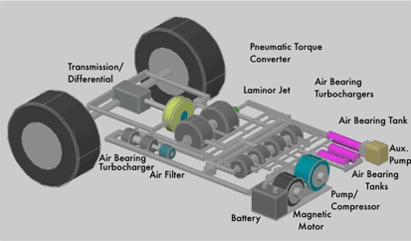Let’s focus here on three alternatives for car engines (out of other possibilities such as batteries): The magnetic motor, the thorium engine and the algae biofuel.
The Magnetic Motor

We owe so much to Nikola Tesla.
The magnetic motor works on the simple principle that we all already know, ‘Like poles repel each other while opposite poles attract each other’.
By arranging the magnets in a fashion where only like poles face each other, one can simply set the motor into motion. Once the motor is set into motion, one can treat it like a turbine and extract electrical energy out of it.
The device can be made to work a little better if a electromagnet replaces the opposing magnet in this setup. This is because, one can quickly switch the poles of an electromagnet. Although, this will require some amount of electricity to make the electromagnet work, the output of the magnetic motor will be much higher than the power used to operate the electromagnet.
Efficiency of the device can be further increased by changing the design of the motor and positioning magnets in a way where the motor can run easily.
There is one major flaw in this whole setup though. The electrical energy that can be generated out of such a system seems to be created out of no fuel at all and that is stumbling everybody.
So far, all we know is that to generate electricity, we need some sort of a source, rays of the sun, kinetic energy from flowing water, or at least some fuel to be burnt so that the turbines can move and generate electricity.
Challenging The Notion
But the magnetic motor challenges this notion and tells us that all you need is an arrangement of magnets to put the motor in motion and generate electricity. For many people, this seems to be breaking the law of conservation of energy and thus making this concept very difficult to accept!
In reality however, it is the magnetic energy that is being used to put the motor into motion and over a period of time, the magnets will lose their magnetism and the motor will stop.
But again, all one needs to do is replace the magnets and the motor will be workable once again. There is some work that has been put into the type of magnets that can be used for such motors and Neodymium magnets have been claimed to offer the best results.
Yet Another Magnet Car Concept

This magnetic vehicle concept overcomes the force of gravity by finding an unusual solution to the problem of expending fuel to get somewhere.
Rather than seeking a different fuel source, or building a smaller car, this concept ingeniously reduces the weight of the car by using an electric engine with magnets the same polarity as the roads.
The resulting upward force lightens the vehicle’s weight by 50%. Another innovative touch is the desing of the seats: two outer layers, pile yarn, and a soft construction foam make it possible to adjust the final hardness and spring characteristics of the seat. This lightweight, adaptable seating not only cuts down on waste during construction and the overall weight of the vehicle while being driven, it also sounds pretty darn comfy.
Of course, the biggest caveat to this vehicle’s road dominance is the very crux of it’s construction: in order for the magnetic engine to properly polarize, the roads on which it’s driven also have to be magnetized. Magnetic roads not being yet readily available, the design for right now remains purely theoretical.
The Thorium Engine
Thorium is a weakly radioactive chemical element with symbol Th and atomic number 90. Thorium metal is silvery and tarnishes black when exposed to air, forming the dioxide; it is moderately hard, malleable, and has a high melting point. Thorium is an electropositive actinide, whose chemistry is dominated by the +4 oxidation state; it is quite reactive, prone to ignition on air when finely divided.
How Does A Thorium Reactor Work?
Car Runs For 100 Years Without Refueling
“If your car was powered by thorium, you would never need to refuel it. The vehicle would burn out long before the chemical did. The thorium would last so long, in fact, it would probably outlive you. The element is radioactive, and the team uses bits of it to build a laserbeam that heats water, produces steam, and powers an energy-producing turbine.”
– The Young Turks
According to Robert Hargraves, founder at ThorCon International (“Powering up our world with cheap, reliable, CO2-free electric power. Now.”) low or non-CO2 emitting energy sources must be cheaper than coal or will ultimately fail to displace fossil fuels.
A ThorCon plant requires less of the planet’s resources than a coal plant. Assuming efficient, evidence-based regulation, ThorCon can produce clean, reliable, CO2-free electricity at 3 cents per kilowatt-hour – cheaper than coal.
With CO2 emissions climbing seemingly beyond all bounds, pessimism is rampant and bold ideas are needed.
The Algae Biofuel
Algae can provide a diverse and highly desirable non-food source of the important renewable molecules that can be used to produce second generation biofuels. Some strains of algae can be optimised to produce bio-diesel precursors.
Algae has been regarded as a potential sustainable fuel option, but researchers have been hindered for the past decade in developing a strain that is high in oil content and grows quickly. The ability to sustain growth while increasing oil content is an important advance.
Algae has other advantages over traditional biofuels because it can grow in salt water and thrive in harsh environmental conditions, therefore limiting stress on food and fresh water supplies. While the breakthrough is an important step, the technology is still many years from potentially reaching the commercial market, but nevertheless, progress is being made.
What’s More

My Blog (58)
Dependence (5) Fiction (7) Karma (6) Landmarks (4) Paramount (5) Poignancy (5) Spectrum (6) Spotlight (5) Take Off (5) Unique (5) Virtue (5)
Amazing Stuff (9) Beyond Known (8) Controversial (10) Digital World (9) Inequities (8) Innovative (8) Metaphysics (8) Our Society (9) Outer Space (9) Value Creation (9)









